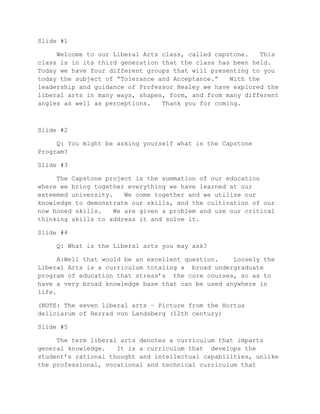
Capston ss intro
- 1. Slide #1 Welcome to our Liberal Arts class, called capstone. This class is in its third generation that the class has been held. Today we have four different groups that will presenting to you today the subject of “Tolerance and Acceptance.” With the leadership and guidance of Professor Healey we have explored the liberal arts in many ways, shapes, form, and from many different angles as well as perceptions. Thank you for coming. Slide #2 Q: You might be asking yourself what is the Capstone Program? Slide #3 The Capstone project is the summation of our education where we bring together everything we have learned at our esteemed university. We come together and we utilize our knowledge to demonstrate our skills, and the cultivation of our now honed skills. We are given a problem and use our critical thinking skills to address it and solve it. Slide #4 Q: What is the Liberal arts you may ask? A:Well that would be an excellent question. Loosely the Liberal Arts is a curriculum totaling a broad undergraduate program of education that stress’s the core courses, so as to have a very broad knowledge base that can be used anywhere in life. (NOTE: The seven liberal arts – Picture from the Hortus deliciarum of Herrad von Landsberg (12th century) Slide #5 The term liberal arts denotes a curriculum that imparts general knowledge. It is a curriculum that develops the student’s rational thought and intellectual capabilities, unlike the professional, vocational and technical curriculum that
- 2. typically emphasize a distinct specialization in a field. In today’s day and age the liberal arts means studying a little of everything, literature, languages, philosophy, history, mathematics, and science. Slide #6 (NOTE: Socrates pictured on Left) The concept of learning just because one loves to learn was brought about by Socrates, who is considered “the father of western philosophy.” He believe d there was more to learning then just understanding the basics necessary to survive. Socrates taught by walking around and proposing questions and potential answers. Although he never wrote down his concepts and beliefs, others recorded his thoughts ideas and conversations as notes. One of his most famous and recognized students was Plato. Yet it was Plato who established the first true school of Academia, called “the Academy” in 385 B.C. Still it was not set up as schools are today with desks and black boards, he stayed true to Socrates methodology of teaching on a exploratory walk. Plato seems to have carried on the philosophy of Socrates, concentrating on the dialectical examination of basic ethical issues: what is friendship? what is virtue? can virtue be taught? and more. Plato’s most famous student was Aristotle. (NOTE: Pictured on right hand of the slide, Plato on right, Aristotle on left) Slide #7 Philosophy is the study of general and fundamental problems, such as existence, knowledge, values, reason, mind, and language. It is distinguished from other ways of addressing such problems by its critical, generally systematic approach and its reliance on rational argument. The word "philosophy" comes from the Greek “philosophia”(φιλοσοφία), which literally means "love of wisdom", and was originally a word referring to the special way of life of early Greek philosophers.
- 3. Slide #8 Here are shown how the seven liberal arts was broken down: The Trivium: A word that is a Latin term meaning “the three ways” or “the three roads” forming the foundation of a medieval liberal arts education. This study was preparatory for the quadrivium. Grammer; is the mechanics of a language; Logic(dialectic); is the "mechanics" of thought and analysis; Rhetoric; is the use of language to instruct and persuade. the Quadrivium; is comprised of four subjects, or arts, taught after the trivium. The word is Latin, and means "the four ways" or "the four roads". Together, the trivium and the quadrivium comprised the seven liberal arts. The quadrivium was considered preparatory work for the serious study of philosophy and theology. The Four original subjects of the Quadrivium were arithmetic, astronomy, music, and geometry. Slide #9 As time has progressed we have adapted, honed and refined these concepts. The Trivium has been translated into the humanities. Slide #10 The Quadrivium has become the Sciences and Mathematics. Slide #11 Put the two together and you have a school of thought that has truly given you a wide spread resource to turn and use as we progress into scholars in this day and age. It is us that truly are the lucky ones, we can do anything anywhere for we have the knowledge to do so, and to adapt to any problem that comes across our paths.
- 4. “Gratias ago vos magister vigoratus , vos have paratus nos ineo orbis terrarum , neque nec tantum sedeo in is tamen ut thrive , ut verus scholasticus.” Thank you Professor Healy, you have prepared us to enter the world, and not only reside in it but to thrive, as true scholars.